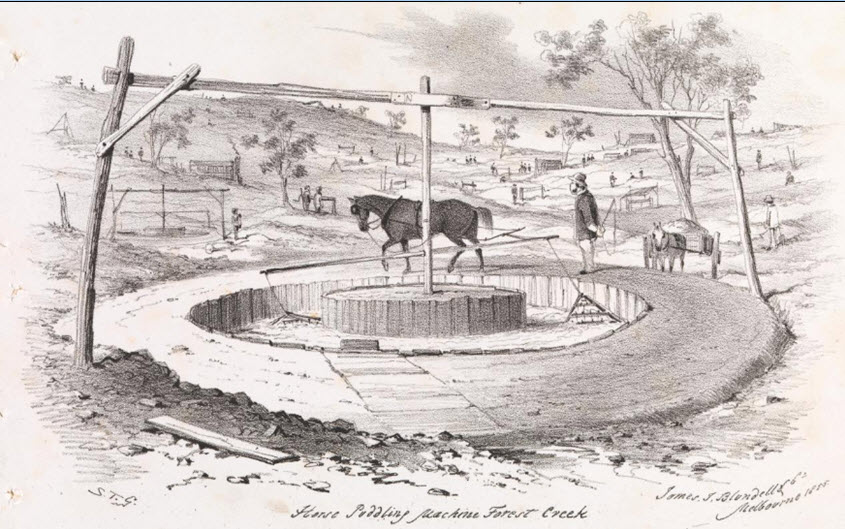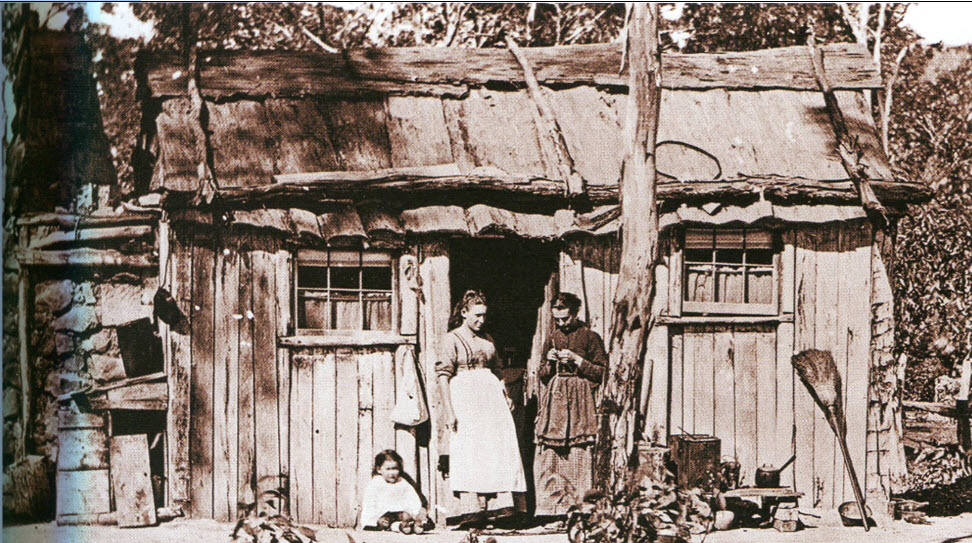1. Of the many transient prospectors, a few settle here on the “Flat” in the 1850’s
During the early years of Australia’s 1st gold rush, thousands of hopeful prospectors made their way through this wattle (Acacia) filled hilltop flat near the end of their very long journeys to Sofala & the Turon River diggings.
It was soon recognised that this hilltop flat also had rich gold but it was initially more difficult to extract from the clay rich soil than from the river gravels at Sofala. When for various reasons the Sofala diggings were problematic or worked-out, places like Wattle Flat became attractive. The flats along the creek just downslope from here would have been rich in alluvial gold which was shedding from a large outcropping quartz reef on this site.
Families that settled in Wattle Flat in the 1850’s include: McCabe, Beath, McCudden, Brailey, McAtamney, Stuart, Morehouse & Bright & others.
Mid 1850’s : Dozens of puddling machines in Wattle Flat
During the mid-1850’s hundreds of miners would have been hard at work extracting gold from the clay rich soil. Hundreds of pits & shafts were dug giving the ground an egg-box like appearance. To efficiently break up the heavy clay soil found in this area, machines were constructed that are known as “horse puddlers” or “puddling machines”. These consisted of a donut shaped water filled trough around which a horse would haul a weighted sledge as shown in the image below. Raw clay would be dumped in the trough to be softened & broken by the sledge in preparation for washing in a gold pan or rocker box. Apparently there were dozens of these “puddling machines” in Wattle Flat, and traces of them can still be found today. There is a replica “puddling machine” on display at the Bathurst Goldfields Educational Centre on Mt Panorama.

A typical puddling machine

A typical timber slab home
The first post office in Wattle Flat is established here (where car park is now)
Taking advantage of all this alluvial mining activity around Solitary, several families had settled & built timber slab homes with gardens. A few settlers established stores & hotels. Among these were George Morehouse whose home & store established near where the car park is today. He ran Wattle Flat’s first post office service from this store. Henry Stuart established another store where the brick building across the road stands today.
1858: Solitary Quartz Reef mining starts
As early as 1852 some more experienced gold miners recognised the richness of the Solitary Quartz Reef and sought permission to mine it. The colonial authorities initially denied permission because it might disrupt the lucrative alluvial mining being undertaken close by. By 1858 the alluvials became depleted and large numbers of alluvial miners had moved-on seeking more productive alluvial diggings. More than 20 mining claims had been taken out along the Solitary quartz reef, and some shafts were already deep within the quartz reef structure.
1858: Chinese pass through Wattle Flat en-route to the Turon
In 1858 very large parties of Chinese prospectors made their way through Wattle Flat to the Turon River diggings. Over the previous years, Chinese miners had focused on the larger goldfields north of Melbourne, but new discriminatory taxes made the Turon a better option for them in 1858. During the early 1860’s about 50% of the Turon mining population were Chinese. Some settled in Wattle Flat & established gardens.
1861 : Wattle Flat’s 1st stamp battery arrives
In order to economically work a quartz reef mine, there must be a stamp battery machine nearby to crush the quartz. Stamp batteries need a good supply of water to operate. Wattle Flat’s 1st stamp battery was installed in 1861 on the banks of Big Oakey Creek 2km east of the Solitary Reef. It was costly to cart the quartz across the flats, so only the richest quartz would have been sent .